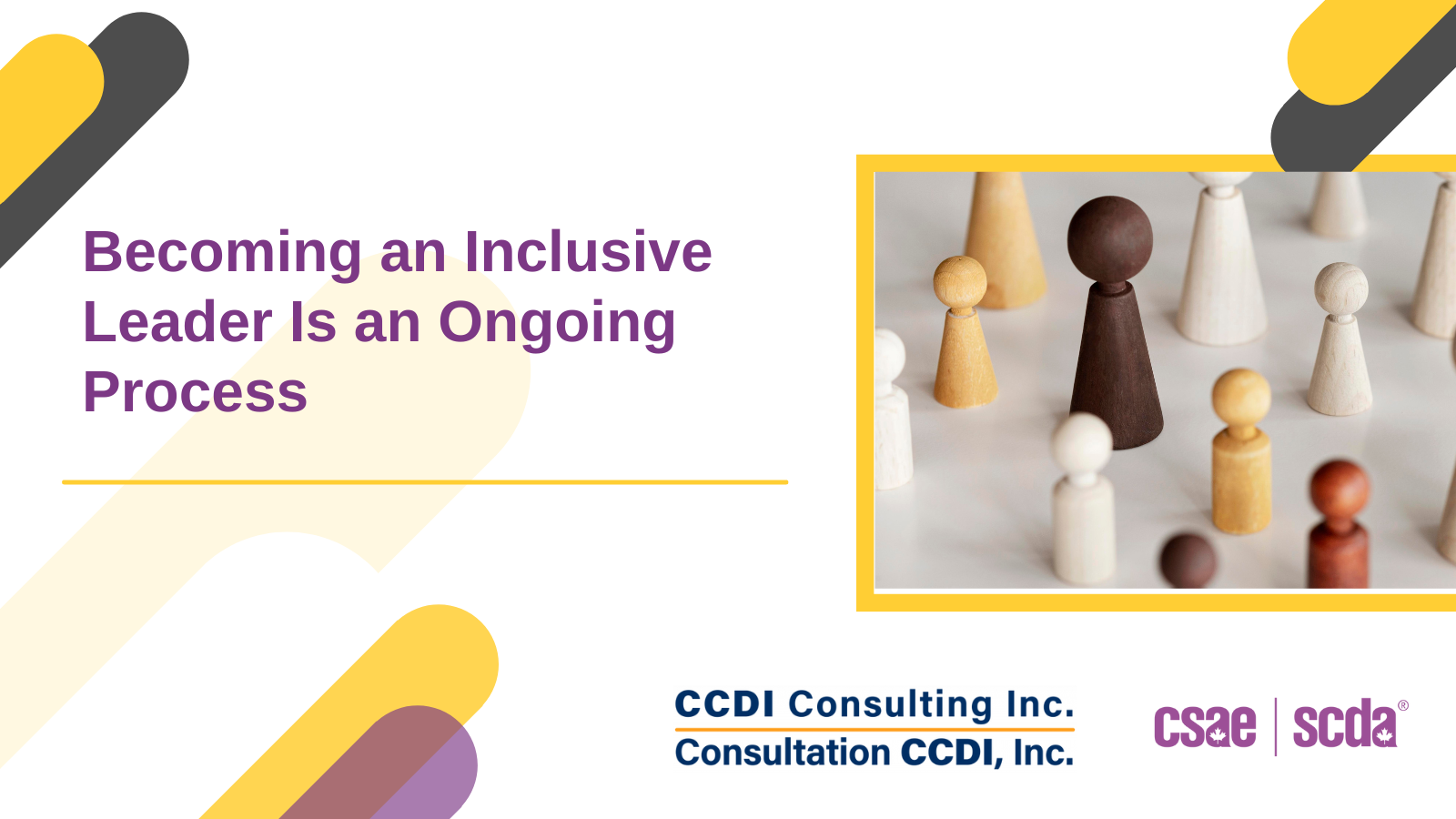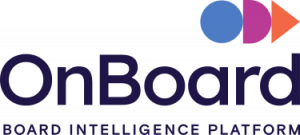Becoming an Inclusive Leader Is an Ongoing Process

Inclusive leaders value and respect diversity, promote equity and foster a sense of belonging in the workplace. They create a work environment where all employees feel welcomed, respected and valued, regardless of their backgrounds or identities.
Inclusive leadership involves actively seeking out and listening to diverse perspectives, being open to feedback and learning, and creating opportunities for all employees to contribute and succeed. It also involves recognizing and addressing bias, systemic inequalities and barriers to diversity and inclusion.
Inclusive leaders promote collaboration, teamwork and a sense of community, which leads to increased employee engagement, job satisfaction and productivity. They also support and empower their employees by providing opportunities for growth and development and recognizing and rewarding their contributions.
Thus, inclusive leadership is critical to building a diverse and equitable workplace culture that benefits everyone. It requires intentional effort and ongoing commitment from leaders to create a work environment that values and celebrates diversity and fosters a sense of belonging for all employees.
What is Workplace Inclusion?
Workplace inclusion refers to creating a work environment where all employees feel welcomed, valued and respected for who they are, regardless of their backgrounds or identities. It involves creating a culture that recognizes diversity and fosters equity and belonging. Everyone is encouraged to contribute their unique perspectives and talents.
Workplace inclusion is essential because it promotes a positive work environment that benefits employees and the organization. Inclusive workplaces are more likely to attract and retain diverse talent. They also encourage creativity and innovation, and foster better teamwork and collaboration.
Inclusion in the workplace involves a range of practices and behaviours, including:
- Valuing diversity: Recognizing and appreciating differences in race, gender, sexual orientation, religion, ability, age and other aspects of identity
- Fostering equity: Providing fair and equitable treatment, opportunities and resources to all employees, regardless of their backgrounds or identities
- Encouraging belonging: Creating a sense of community and belonging where all employees feel welcomed and respected
- Addressing bias and discrimination: Taking steps to prevent and address workplace bias or discrimination incidents
- Providing education and training: Providing education and training to all employees on diversity, equity and inclusion topics to promote awareness and understanding
What is Workplace Diversity?
Workplace diversity refers to the differences in race, ethnicity, gender, age, sexual orientation, religion, ability and other aspects of identity among employees in a workplace. It encompasses the range of differences that exist among people and their experiences.
Diversity in the workplace is becoming increasingly important as employers recognize the benefits of having a diverse workforce. Research has shown that diverse teams are more innovative, creative and better at problem-solving. Additionally, organizations with diverse workforces are more likely to attract and retain top talent. They are better positioned to meet the needs of diverse stakeholder and client bases.
Workplace diversity includes both visible and invisible aspects of identity, such as:
- Race and ethnicity: Differences in skin colour, ethnic background and nationality
- Gender: Differences in gender identity, expression and presentation
- Age: Differences in age and generation
- Sexual orientation: Differences in sexual orientation and attraction
- Religion: Differences in religious beliefs and practices
- Ability: Differences in physical or mental ability
- Other aspects of identity: Differences in socio-economic status, education, language, culture and more
In summary, workplace diversity refers to the range of workplace employee differences, including visible and invisible aspects of identity. It is becoming increasingly important for organizations to recognize the value of diversity in the workplace and to create a culture of inclusion that values and respects all employees.
What is Workplace Equity?
Workplace equity refers to the fair treatment of employees, regardless of their backgrounds or identities. It involves ensuring that all employees have access to the same opportunities, resources, and benefits, regardless of their race, ethnicity, gender, sexual orientation, religion, ability or other aspects of identity.
Equity in the workplace is different from equality, which assumes that everyone has the same needs and experiences. Equity recognizes that employees may have different needs and experiences based on their backgrounds and identities and seeks to address those differences by providing support and resources as needed.
Workplace equity involves a range of practices and behaviours, including:
- Providing fair compensation: Ensuring that all employees are paid fairly for their work, regardless of their backgrounds or identities
- Ensuring access to opportunities: Providing equal access to career advancement opportunities, training and development programs
- Providing support: Providing support and resources to employees who may face additional barriers due to their backgrounds or identities, such as offering flexible work arrangements or accommodations for employees with disabilities
- Addressing bias: Taking steps to prevent and address workplace bias or discrimination incidents
- Providing education and training: Providing education and training to all employees on diversity, equity and inclusion topics to promote awareness and understanding
So we see that workplace equity refers to the fair treatment of employees, regardless of their backgrounds or identities. It involves providing equal access to opportunities and resources and addressing barriers that may affect certain groups of employees. Workplace equity is essential for creating a culture of inclusion and promoting a positive work environment for all employees.
Why is Inclusive Leadership Important?
Being an inclusive leader is vital for several reasons:
- Increases employee engagement: Employees who feel included and valued are more engaged in their work, leading to higher productivity and job satisfaction.
- Improves team performance: An inclusive leader promotes collaboration, trust and open communication, leading to better team performance and outcomes.
- Attracts and retains top talent: Inclusive leaders attract and retain top talent by creating a culture of inclusivity that values diversity and supports individual differences.
- Enhances creativity and innovation: An inclusive leader encourages diverse perspectives and ideas, leading to more creative and innovative solutions.
- Fosters a positive work environment: An inclusive leader creates a positive environment where all employees feel welcome, respected, and valued for their unique contributions.
- Increases profitability: Studies have shown that companies with diverse and inclusive leadership teams are more profitable than those without.
Being an inclusive leader is not only the right thing to do, but it also has significant business benefits. It creates a positive work environment, improves team performance and attracts and retains top talent, increasing results and success.
What Does it Take to Be an Inclusive Leader?
Inclusive leaders require intentional effort and ongoing commitment to learning and growth. Here are some steps you can take to become an inclusive leader:
- Educate yourself: Learn about different cultures, identities, and experiences to increase your awareness and understanding of diversity and inclusion issues. Attend training and workshops on cultural competence, unconscious bias, and inclusive leadership.
- Examine your biases: Be aware of your own biases and how they might impact your decision-making and interactions with others. Work to identify and challenge your assumptions and stereotypes.
- Practice active listening: Actively listen to others, seek out diverse perspectives, and ask questions to understand their experiences and viewpoints better.
- Foster a sense of belonging: Create a work environment where everyone feels welcomed, valued, and included. Encourage teamwork, collaboration, and open communication. Celebrate diversity and provide opportunities for all employees to contribute and succeed.
- Address bias and discrimination: Address any workplace incidents of bias or discrimination. Take steps to prevent future incidents by setting clear expectations, providing training, and holding employees accountable.
- Lead by example: Model inclusive behaviour and hold yourself and others accountable for creating an inclusive work environment. Foster a culture of respect and empathy.
- Continuously improve: Regularly assess your leadership style and seek feedback from others. Be open to learning and growth. Make changes as needed to ensure that you are effectively leading and supporting all employees.
By taking these steps, you can promote diversity, equity and inclusion in the workplace and create a positive and supportive work environment for all employees.
Becoming an Inclusive Leader is an Ongoing Journey
Becoming an inclusive leader is an ongoing process that takes time, effort and commitment. There is no set timeline or specific duration for becoming an inclusive leader. It depends on individual factors, such as the person’s experience level, knowledge and skills.
Some people may naturally be inclined towards inclusive leadership. Others may need more time and practice to develop their skills. Additionally, the level of support and resources available to the person can also impact how quickly they develop as an inclusive leader.
Also, it is essential to note that becoming an inclusive leader is not a one-time event or a box to be checked off. It is an ongoing process that involves continuous learning, self-reflection and improvement. Inclusive leadership requires a long-term commitment to creating a culture of diversity, equity and inclusion in the workplace, and it is a journey that never truly ends.
Further Reading on Benefits of Inclusive Leadership
Here are five studies that discuss the benefits of inclusive leadership for organizations:
The Business Case for Diversity and Inclusion by McKinsey & Company (2015)
This report shows that companies with diverse workforces are more likely to achieve better financial performance, including higher revenue and profits. It also highlights the importance of inclusive leadership in creating a culture of diversity and inclusion within organizations.
Inclusive Leadership: The View From Six Countries by Deloitte University Press (2017)
This report discusses the benefits of inclusive leadership, including increased employee engagement, better decision-making, and improved innovation. It also highlights the role of inclusive leadership in promoting diversity and inclusion within organizations.
The Power of Inclusive Leadership by Catalyst (2018)
This report shows that inclusive leadership can help organizations attract and retain top talent, increase innovation and creativity, and improve financial performance. The report also guides how organizations can develop inclusive leadership skills among their leaders.
Why Inclusive Leaders Are Good for Organizations, and How to Become One by Harvard Business Review (2019)
This article discusses the benefits of inclusive leadership, including increased employee engagement and retention, better decision-making, and improved innovation. The article also provides guidance on how leaders can develop their inclusive leadership skills.
The Business Case for Inclusive Leadership by Center for Talent Innovation (2021)
This report looks into how inclusive leadership can help organizations better understand and serve diverse customer and client bases, as well as increase innovation and creativity. It guides organizations on how they can develop inclusive leadership skills among their leaders.






















